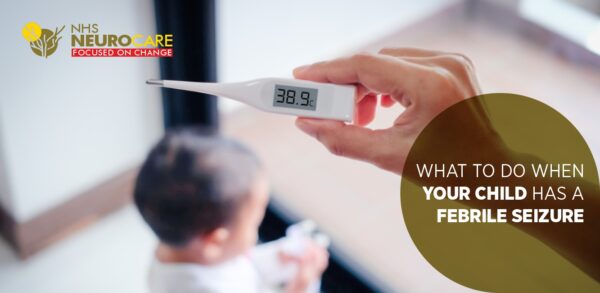Know how to treat a febrile seizure when it happens
If you are a parent of a child below five years of age and have had the distressing experience of watching your child have a bout of fits, you may want to know what is going on and what to do. What your child most likely has experienced is a case of febrile seizures. Febrile seizures are fits that can happen generally to a child aged between six months and three years.
While it can be extremely painful to watch your young child go through a seizure, you need to know that most cases are benign and have no lasting impact on your child’s intellectual or physical development. It will however be useful to explore constructive steps that you can take to understand this condition and prevent any harm from febrile seizures.
In this blog post, we delve into the essential steps to take during a febrile seizures and emphasize the importance of seeking expert care with Dr. Sandeep Goel, the best neurologist in Jalandhar, Punjab, India.
Diagnosis of a febrile seizure
Generally 2-5% of children below five years of age experience febrile seizures. A febrile seizure is generally known to occur within 24 hours of a fever above 38℃ caused by a viral infection. A febrile seizure is differentiated from an epileptic seizure in that the child is neurologically healthy and has no sign of intracranial infection.
Some of the common characteristics of a febrile seizure are:
- Body stiffness or throwing movement
- Fits that last for below 15 minutes
- Loss of consciousness or awareness of the seizure
The doctor may want to rule out any other complex reasons for the seizure and will look into the medical history of the child, especially if the child has received all vaccinations on time. In case of any delayed vaccinations the doctor may ask for a few tests to rule out more serious causes for the seizure. These can include;
- Blood tests
- Urinalysis
- A spinal tap to check for meningitis
In some cases, doctors may conduct an electroencephalogram (EEG) or/ and an MRI if there may be any cause to suspect abnormal neurological activity. Doing these tests will ascertain the underlying causes for the seizure and ensure to correctly diagnose the seizure. In case the doctor suspects epilepsy that is a neurological disorder causing abnormal brain activity and seizures, then epilepsy treatment will follow a different path.
When do you need to see a doctor
As mentioned before, most febrile seizures do not need special medical intervention. However, with some symptoms it is advised to take your child to a doctor. You should consult our best Neurologist Dr Sandeep Goel or schedule a health screening if you want to learn more about febrile seizure.
when the fever is very high and shows no signs of reducing
- fits lasts longer than 15 minutes
- vomiting with the fits
- repeated seizures
- prolonged disorientation after the seizure
- the child is younger than six months
- there is reason to believe that the child may be experiencing non-febrile seizures
Febrile seizures treatment and prevention
You need to know what you ought to do when your child has a febrile seizure. Febrile seizures treatment involves clear steps that you can take to prevent any harm being caused to the child at the time of the seizure. Best Neurologist Dr. Sandeep Goel’s expertise in neurology ensures accurate identification and tailored treatment plans.
Treatment
Stay calm and comfort the child: Do not panic and cause more alarm to the child. Staying calm and reassuring the child helps calm the child as well.
Place the child on its side or on their stomach: This is essential to prevent choking on their own spit or vomit.
Loosen clothing: Ensure the child’s clothing does not restrict his/ her breathing with a full chest.
Fever Management: Use appropriate fever-reducing medications, such as acetaminophen (Tylenol) or ibuprofen, as recommended by your child’s healthcare provider.
Hydration: Ensure your child stays well-hydrated, especially if the fever is accompanied by symptoms of dehydration (e.g., reduced urine output, dry mouth).
Prevention
Identify and Treat Underlying Illness: Address the cause of the fever by identifying and treating the underlying illness or infection. Consult with your child’s healthcare provider to determine the appropriate course of action.
Fever Monitoring: Monitor your child’s temperature regularly, especially during an illness. Be proactive in managing fevers to prevent them from rising to levels that could trigger seizures.
Prophylactic Medications: In some cases, especially if your child has a history of recurrent febrile seizures, your healthcare provider may prescribe antiepileptic medication to be taken during febrile illnesses. However, this is not a common practice and is usually reserved for specific situations.
Vaccinations: Staying up-to-date with vaccinations can help prevent some of the infections that may lead to febrile seizures.
Prompt Medical Attention: Seek prompt medical attention if your child develops a fever, especially if it is associated with other concerning symptoms.
Educate Caregivers: Ensure that caregivers, including family members and childcare providers, are aware of your child’s history of febrile seizures and are trained in appropriate fever management. Dr. Sandeep Goel as your best neurologist in Jalandhar, Punjab, India, ensures that you receive the highest quality of care during such critical moments.
His commitment to patient well-being extends beyond the immediate crisis, as he works diligently to develop comprehensive treatment plans that address both short-term recovery and long-term neurological health.
Remember, time is of the essence when it comes to febrile seizure. Dr. Sandeep Goel’s expertise as the best neurologist in Jalandhar, Punjab, India, provides a lifeline for those navigating the challenges of neurological emergencies.
Act swiftly, seek help, and trust in the hands of a seasoned professional to guide you toward a healthier tomorrow. Your well-being is our priority, and with the best neurologist Dr. Sandeep Goel, you’re in the best hands for neurological care in Jalandhar, Punjab, India.

